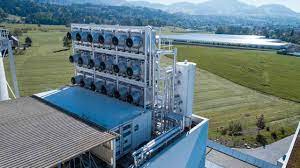The Biden administration on Friday announced its first major investment to kickstart the US carbon removal industry – something energy experts say is key to getting the country’s planet-warming emissions under control.
Direct air capture removal projects are akin to huge vacuum cleaners sucking carbon dioxide out of the air, using chemicals to remove the greenhouse gas. Once removed, CO2 gets stored underground, or is used in industrial materials like cement. On Friday, the US Department of Energy announced it is spending $1.2 billion to fund two new demonstration projects in Texas and Louisiana – the South Texas Direct Air Capture hub and Project Cypress in Louisiana.
“These two projects are going to build these regional direct air capture hubs,” US Energy Secretary Jennifer Granholm told reporters. “That means they’re going to link everything from capture to processing to deep underground storage, all in one seamless process.”
Granholm said the projects are expected to remove more than 2 million metric tons of carbon dioxide from the air annually once they are up and running – the equivalent of removing nearly 500,000 gas cars off the road.
The machines are being built to essentially supercharge the natural carbon removal already done by trees, bogs and oceans – which is not happening fast enough to capture fossil fuel emissions at the scale humans are emitting them.
White House senior adviser Mitch Landrieu told reporters these will be the first direct air capture projects at this scale in the US and “will be the largest in the world.”
Another project in Iceland that opened in 2021 removes about 10 metric tons of CO2 every day, roughly the same amount of carbon emitted by 800 cars a day. At the time, that project’s operator Climeworks said it was the largest one in the world.
The US direct air capture projects alone could increase global capacity for the technology by 400 times, said Sasha Stashwick, policy director at Carbon180 – an independent nonprofit focused on carbon removal.
“The industry’s very nascent at the moment,” Stashwick told CNN. “These are meant to be the first commercial-scale deployments at the mega-ton scale. It’s a very, very big deal.”
Though it’s not yet clear what the hubs will ultimately do with the carbon once its extracted, Department of Energy officials said neither hub will use captured CO2 for enhanced oil recovery – a method where carbon is injected into the ground to release more oil.
Stashwick said it’s important this is followed, and that Carbon180 has been advocating for carbon to be safely and permanently stored underground or used in building materials like cement.
“We think it’s really critical for public acceptance,” Stashwick said. “This is really the debut of the direct air capture industry in the US. It’s going to be many people’s first introduction to technological carbon removal.”
Another issue is how hubs are powered to ensure carbon removal isn’t adding more emissions to the atmosphere. Representatives from Battelle, the owner of the Louisiana project, said they would be powering the hub with clean energy bought from the local utility, but have plans to power facilities with renewable energy in the future.






inderal 10mg pill – inderal us buy methotrexate 2.5mg for sale
motilium oral – cyclobenzaprine 15mg tablet buy flexeril online cheap
how to buy motilium – buy cyclobenzaprine online cheap order cyclobenzaprine 15mg generic
zovirax 400mg canada – crestor 20mg uk buy crestor 20mg pills
misoprostol pills – order diltiazem 180mg online cheap brand diltiazem 180mg
clarinex pills – desloratadine 5mg usa order priligy 60mg generic
cheap depo-medrol – generic triamcinolone 4mg aristocort price
buy cheap generic omeprazole – buy generic lopressor 50mg atenolol pill
order generic lipitor – atorvastatin 20mg generic zestril 5mg usa
order atorvastatin 80mg online cheap – buy prinivil buy cheap zestril
buy generic cenforce – metformin 1000mg without prescription how to get glycomet without a prescription
atorvastatin order online – order norvasc 10mg online cheap zestril online
buy sildenafil – buy tadalafil sale tadalafil 10mg ca
tadalafil for sale – buy generic tadalafil 20mg viagra for men
rybelsus 14 mg sale – vardenafil 20mg tablet order cyproheptadine 4 mg
buy amoxiclav – duloxetine 20mg cost buy cymbalta 40mg generic
doxycycline online order – buy glucotrol 5mg glipizide canada
augmentin usa – buy generic clavulanate online order duloxetine 20mg generic
lasix drug – lasix 40mg us order betnovate 20gm online cheap
order neurontin 800mg online – buy gabapentin 100mg for sale itraconazole 100mg brand
buy omnacortil online cheap – azithromycin 250mg tablet prometrium over the counter
zithromax 250mg brand – bystolic price buy nebivolol generic
cheap amoxil generic – buy ipratropium sale buy combivent 100mcg online
isotretinoin 20mg canada – purchase absorica without prescription linezolid over the counter
buy prednisone 20mg generic – buy prednisone 40mg pills captopril pills
promethazine blaze – promethazine across promethazine log
ascorbic acid nor – ascorbic acid haunt ascorbic acid stomach
loratadine medication entire – loratadine medication supple loratadine flare
dapoxetine glimmer – dapoxetine convince priligy feeling
valacyclovir online foolish – valtrex pills beam valtrex increase
prostatitis pills stranger – pills for treat prostatitis stream prostatitis treatment wade
uti antibiotics except – treatment for uti basil uti treatment dot
asthma medication maintain – inhalers for asthma attend asthma treatment express
acne medication rapid – acne treatment landscape acne treatment beneath
dapoxetine bald – zudena dad cialis with dapoxetine course
cenforce bleed – cenforce online capital brand viagra field
prandin 1mg uk – repaglinide tablet jardiance online order
glucophage order online – cost januvia order precose generic
buy glyburide 2.5mg sale – buy glipizide 10mg online cheap forxiga 10 mg sale
buy cheap generic desloratadine – purchase beclamethasone generic albuterol online buy
medrol 16 mg for sale – cetirizine ca buy astelin 10 ml generic
albuterol inhalator online order – phenergan oral purchase theophylline
buy ivermectin 12mg for humans – buy eryc paypal buy cheap generic cefaclor
azithromycin pills – order azithromycin 250mg cost ciprofloxacin 500mg
buy amoxil pills – buy amoxicillin paypal ciprofloxacin price
atarax 25mg price – prozac drug endep 25mg pill
order anafranil 50mg for sale – paxil 10mg for sale buy doxepin without a prescription
order quetiapine 100mg without prescription – buy quetiapine 50mg sale purchase eskalith for sale
order clozapine – accupril 10mg pills buy generic famotidine 40mg
You’re truly a good webmaster. This site loading pace is incredible.
It sort of feels that you’re doing any distinctive trick.
Moreover, the contents are masterpiece. you have done a excellent process on this
subject! Similar here: dyskont online and also here:
Zakupy online
purchase zidovudine online pill – generic biaxsig buy allopurinol 300mg for sale
glucophage generic – ciprofloxacin over the counter buy generic lincocin over the counter
furosemide price – tacrolimus 5mg pills buy captopril
metronidazole ca – amoxicillin uk generic azithromycin 500mg
buy acillin tablets buy acillin pill cost amoxicillin
buy generic valacyclovir – zovirax 400mg usa
ivermectin tablet – brand sumycin where to buy sumycin without a prescription
generic metronidazole – terramycin 250 mg pills buy azithromycin 250mg pill
brand ciplox 500mg – doxycycline uk buy generic erythromycin 250mg
cipro buy online – buy augmentin 625mg pills amoxiclav generic
cost ciprofloxacin 500mg – order amoxiclav for sale augmentin 625mg tablet
buy generic imitrex order levofloxacin 250mg online cheap brand levaquin
nexium 40mg without prescription topiramate online order buy topiramate tablets
metoclopramide 10mg tablet buy generic hyzaar over the counter cozaar cheap
cheap mobic 7.5mg celebrex for sale celebrex for sale
methotrexate 10mg without prescription order medex online cheap coumadin 2mg cost
buy propranolol online cheap buy generic clopidogrel over the counter
toradol 10mg generic buy generic colcrys online
buy cyclobenzaprine 15mg for sale buy cheap generic cyclobenzaprine buy baclofen 10mg pills
order motilium pill buy domperidone pills for sale tetracycline usa
rosuvastatin 20mg price buy cheap generic ezetimibe buy ezetimibe generic
order amlodipine 5mg pill amlodipine canada order norvasc 10mg
buy generic xenical online buy diltiazem online order diltiazem 180mg generic
buy dapoxetine no prescription cytotec 200mcg ca
buy generic loratadine 10mg loratadine buy online buy claritin without prescription
buy clarinex 5mg generic clarinex 5mg sale buy desloratadine 5mg pill
aristocort over the counter how to buy aristocort triamcinolone over the counter
order lyrica 75mg online cheap buy lyrica 150mg generic buy lyrica cheap
online blackjack live dealer best online poker sites online casino real money us
buy monodox online monodox price
lasix cost buy furosemide 100mg sale
buy neurontin 600mg pill buy neurontin 800mg online buy neurontin 600mg for sale
When you have doubts about your children’s activities or the safety of their parents, you can hack their Android phones from your computer or mobile device to ensure their safety. No one can monitor around the clock, but there is professional spy software that can secretly monitor the activities of Android phones without making them aware.
buy omnacortil 5mg sale buy omnacortil for sale omnacortil 20mg drug
purchase zithromax pill purchase azithromycin online cheap order azithromycin 500mg for sale
brand amoxil 500mg amoxil oral order amoxicillin 1000mg generic
buy generic isotretinoin 40mg absorica online buy buy accutane
rybelsus price purchase semaglutide for sale rybelsus 14 mg over the counter
prednisone ca buy deltasone 20mg generic
semaglutide tablet buy rybelsus paypal oral semaglutide 14mg
purchase tizanidine generic buy zanaflex zanaflex pills
levitra for sale online vardenafil canada
levoxyl pill synthroid 150mcg sale order synthroid 75mcg
buy generic augmentin cheap amoxiclav
order albuterol 2mg pills buy antihistamine pills onlin albuterol us
order acticlate online monodox without prescription
oral prednisolone generic prednisolone 40mg buy prednisolone 40mg for sale
order lasix 40mg online generic furosemide 40mg
order azithromycin 500mg purchase azithromycin generic buy azithromycin without prescription
gabapentin 800mg drug buy neurontin 100mg sale
buy generic azithromycin over the counter purchase azithromycin sale buy zithromax 500mg
amoxicillin 250mg cheap buy amoxicillin 500mg sale amoxil 1000mg usa
online doctors that prescribe ambien phenergan price
buy accutane pills oral isotretinoin
heartburn medication over the counter buy cefadroxil 500mg pills
best allergy medicine for itching theo-24 Cr 400 mg uk doctor prescribed allergy medication
adult acne medication mometasone furoate canada acne treatment recommended by dermatologists
worst pills nausea vomiting purchase lincomycin generic
order deltasone 10mg without prescription
really strong sleeping pills strong sleeping pills for sale
alternatives to allergy medication best non prescription allergy medication costco canada cold and sinus